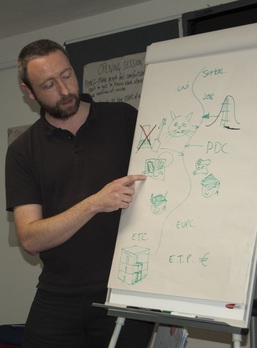|
While working towards my Diploma in Applied Permaculture Design my motivation waxed and waned. In total it took me 6 years to complete it. Here are five ways I found the motivation to finish it off, and some ideas about how you could too.
I eventually realised that for me, the best reason to do the diploma was to actually develop my design skills. From this point, not only did the whole diploma process make a lot more sense, it made me value it more, and it made me realise that the longer I took over it, the more I stood to learn. Paradoxically, this took the pressure off me to finish and allowed me to focus on the learning and enjoying the process. As I started to enjoy the process more, I began to feel that I'd like to help others on the same journey and become a diploma tutor. I was able to visualise myself giving turorials and diversifying my poly-income a little more. Now I really did have an incentive, which focused my mind and allowed me to prioritise diploma work over other things. By really focusing on your own reasons for doing the diploma, identifying the benefits of finishing and visualising yourself afterwards, it can help to keep you on track and keep prioritising the diploma.
This meant that he needed to be observed giving tutorials, performing interim and final portfolio assessments, and running an accreditation event. I realised that if Graham was my tutor, my diploma progress would support his tutor training progress: Graham didn't ask or expect me to do this, but by linking my own progress to his in my own mind, I felt I'd be helping him out by keeping going, and letting him down if I slacked off. This in turn helped to motivate me as I felt somehow accountable to him. Other ways of building in this kind of accountability might be:
3. Get Competitive One permaculture principle promotes cooperation, not competition. But like all principles, there are times when they're helpful and there are exceptions to them. And if we're using nature as a teacher, there are plenty of examples of competition out there, so for me it's a valid permaculture strategy. At the 2013 National Diploma Gathering Graham told me that he'd set a date for two of his other apprentices to hand in their portfolios for their Interim assessments. While I wasn't trying to 'beat' anyone, I didn't want to be the laggard of the group, so I worked hard over the Christmas break to write up enough designs to hand in my portfolio. This in turn meant that I stopped obsessing over the details of the how to format my design write-ups, and allowed me to just get on with it. One way to replicate this effect would be to agree within your peer group to set a date that you're all going to hand in your portfolios. Or at least to set a date when you'll all present a design to each other at a guild meeting.
An additional yield - and therefore incentive - was that I could use my designs to show prospective diploma apprentices the kind of work they might expect to produce and the kind of skills I'll be able to help them with as a diploma tutor. So in this respect, they act like a shop window or marketing tool for me as a tutor. 5. Make the work itself enjoyable
After a long day at the office writing emails and funding applications, the last thing I want to do is come home and write up long-winded design reports. I'd far rather make pretty pictures and lay out pages with nice graphics. And as a picture tells a thousand words, using lots of annotated photograps, drawings and diagrams means MUCH less writing. If the process of creating the portfolio itself feels like an indulgence, you're far more likely to want to do it in your free time. You could do this by thinking about creative processes that you enjoy and make that the basis of (or at least a major element of) your portfolio. Other ways to do this might be use your portfolio as an opportunity to learn a new skill like building a website, making videos, or learning a CAD package.
7 Comments
|
Details
AuthorPermaculturist, Archives
May 2016
Categories
All
|




 RSS Feed
RSS Feed
